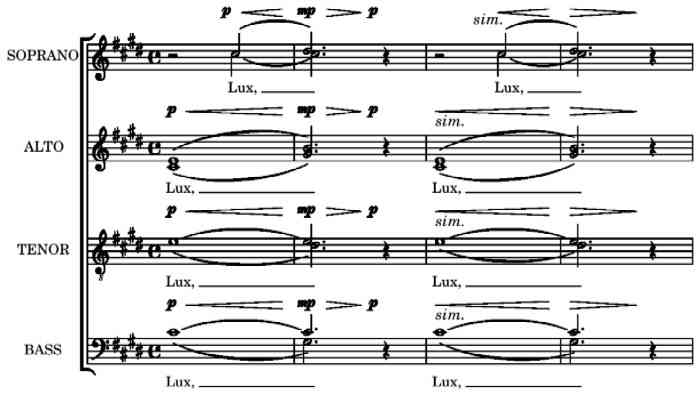
A ural relationships at times bear little relationship to harmonic analysis, or even harmonic function. Stated another way, singing in tune is the result of complex aural/acoustic relationships between and among tones. Those relationships assume a life all their own when placed within the context of vertical harmonic structures. While those relationships appear to defy traditional theoretical knowledge—especially with respect to chromatic movement within harmonic structures—it is clear that choral intonation is a function of the relationship of the tone sung to the harmonic context at that moment. It must be realized that we are using the solfege syllables of Guido d’Arezzo as an intonational device—just as the violinist uses the fingers to ‘place’ a note correctly within its proper intonational context.”
— James Jordan, preface to Matthew LaPine, Prognosticating the ensemble’s ear. in ‘Evoking Sound: The Choral Rehearsal,’ GIA, 2007. (Ch. 16, pp. 147-55).
L ux,H ow exactly does Eric Whitacre’s ‘Lux Aurumque’ work? How can it move us so deeply, so mysteriously? It does this in part through Whitacre’s extensive, deliberate use of beat-frequencies between the parts. For me—and maybe for you as well—the effect is not just the richness of a clashing pair of notes; it’s also the ‘phantom’ note that the beat-frequency of a note-pair implies: the ‘implied’ note that we hear when the dissonance is sounded. That implied or ‘phantom’ note has a pitch equal to the frequency difference between the two dissonant notes—the beat-frequency of the difference in frequency. Close-harmony like this is like a human analogue of ‘voix celeste’ on an organ—phantom notes expressly created by the dissonance beat-frequency. Yes, a choral tune is set as a cantus firmus—but it isn’t purely horizontal: there are all of the vertical/harmonic implications as well as the contrapuntal associations...
calida gravisque pura velut aurum.
et canunt angeli moliter
modo natum.
Light,
warm and heavy as pure gold.
And the angels sing softly
to the new-born babe.”
— Edward Esch (original poem in English), Charles Anthony Silvestri (Latin translation).

M athematically, we should hear the sine wave (f1 + f2)/2 as the average of the two pitches. But the sine part of the right side function alternates between negative and positive values many times during one period of the cosine part, and when this happens only the absolute value of the envelope is perceived. So the beat-frequency we hear is just the difference between the two frequencies: (f1 − f2).
T he violinist Giuseppe Tartini was the first to document this musical effect in the 18th Century, calling it il Terzo Suono (Italian for ‘third sound’). Playing pure harmonies (say, a frequency pair whose members have a simple proportional relation to each other, like 4/5 or 5/6, as in the ‘just intonation’ major and minor third respectively) on the two upper strings, such as the C5 against an open E-string E5, gives the ‘phantom’ C3 two octaves lower.
T he major second (M2) interval of Soprano 2 singing C#5 against Soprano 1 singing D#5 in mm. 2, 4, etc. of ‘Lux Aurumque’ gives the implied C#2 three octaves lower.
T he minor second (m2) between Tenors singing D#4 and E4 in those same bars gives pulsations too low to hear as a pitch per se. This is because, when the dissonance involves two pitches that are close together and pretty low, the frequency of the cosine of the right side of the expression, (f1−f2)/2, is usually too low for us to perceive it as a pitch. Instead, we perceive it as a tremolo-pulsating change in the volume of the underlying pitches. The cosine term creates an amplitude-modulated ‘envelope’ for the sine wave (f1 + f2)/2, the average of the two pitches. So the dissonances in the tenor and bass parts mainly create a wonderful, shimmering tremolando texture. This is even more dramatic in cathedrals or other echoic spaces, where the reverberation and phase relationships between the parts can add yet more richness and acoustic complexity.

No comments:
Post a Comment